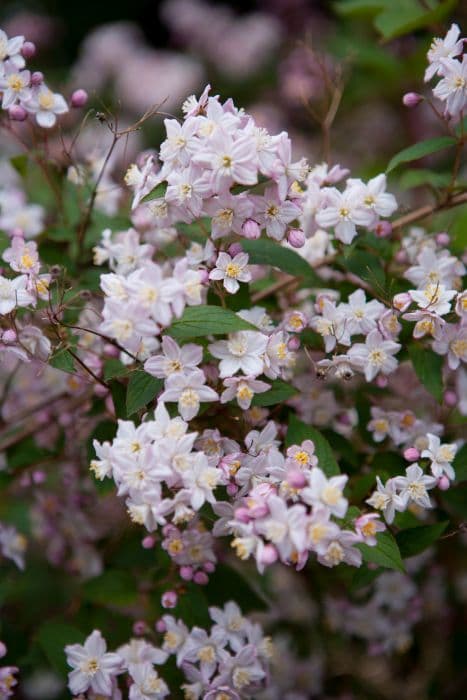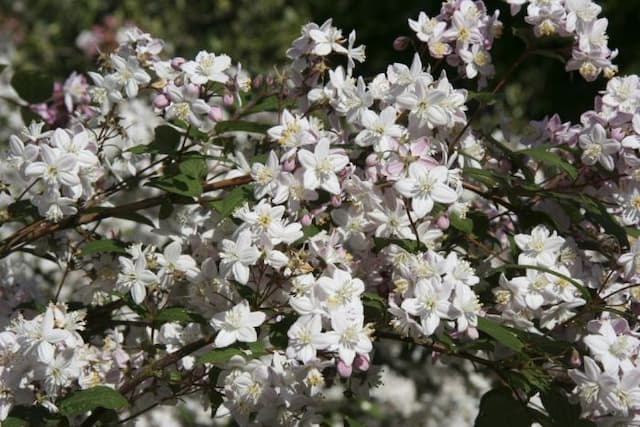Blushing Bride Hydrangea Hydrangea macrophylla 'Blushing Bride' (H)

ABOUT
The Blushing Bride hydrangea is a visually captivating plant known for its large, round flower heads. These flower heads consist of numerous small florets that create a dense, lush inflorescence. The color of the flowers is one of the most striking features—pure white when they first bloom, which gradually develop a blush pink tinge as they mature, imparting a subtle and romantic appearance to the plant. This hydrangea's leaves are dark green, providing a striking contrast to the delicate blooms. The leaves are broad with pronounced veining, exhibiting a somewhat glossy finish that catches the light. Together, the flowers and foliage create a soft, full, and rounded overall aesthetic that is commonly seen in cottage gardens and formal plantings alike. The plant's branching habit is sturdy, supporting the heavy flower heads and ensuring they are presented prominently within the foliage. This makes the Blushing Bride hydrangea a favorite among gardeners for its reliability and ornamental impact. It typically blooms in the late spring through summer, providing a long season of interest in the garden. It's also a popular choice for cut flower arrangements due to its stunning and long-lasting blooms.
About this plant
 Names
NamesFamily
Hydrangeaceae
Synonyms
Blushing Bride Hydrangea, Endless Summer Blushing Bride
Common names
Hydrangea macrophylla 'Blushing Bride'.
 Toxicity
ToxicityTo humans
The bigleaf hydrangea, including the 'Blushing Bride' cultivar, is known to contain compounds that can release cyanide when ingested. The leaves, buds, and flowers may have higher concentrations of these toxic compounds. If parts of the plant are consumed in significant quantities, it can lead to symptoms of cyanide poisoning in humans. The possible consequences of ingestion include nausea, vomiting, stomach pain, and diarrhea. In severe cases, more serious symptoms such as dizziness, difficulty breathing, convulsions, and a rapid drop in blood pressure could occur, which may require immediate medical attention.
To pets
The bigleaf hydrangea is also toxic to pets and can cause similar symptoms of poisoning as in humans. The toxic components can potentially release cyanide when digested, and pets that consume parts of the hydrangea, especially the leaves and flowers, may exhibit signs of poisoning. These symptoms can include vomiting, diarrhea, lethargy, and depression. In severe cases, ingestion can lead to more serious effects such as confusion, cardiovascular collapse, hyperventilation, seizure, and coma. If you suspect your pet has ingested hydrangea, it is important to seek veterinary care promptly.
 Characteristics
CharacteristicsLife cycle
Perennials
Foliage type
Deciduous
Color of leaves
Green
Flower color
White
Height
3-6 feet (0.91-1.83 meters)
Spread
3-6 feet (0.91-1.83 meters)
Plant type
Shrub
Hardiness zones
5-9
Native area
Japan
Benefits
 General Benefits
General Benefits- Aesthetic Appeal: Adds visual interest to gardens with its large, showy blooms that can range from pure white to pink shades.
- Seasonal Interest: Offers spring to summer blooming season, providing long-lasting flowers that can change color based on soil pH.
- Landscape Versatility: Can be used as a solitary specimen, in group plantings, or as part of a mixed border for landscape design.
- Shade Tolerance: Thrives in partial shade, making it a great option for gardens with limited direct sunlight.
- Wildlife Attraction: Attracts pollinators such as bees and butterflies, contributing to the health of the local ecosystem.
- Garden Performance: With proper care, it is known for its reliable blooming and can recover well from winter cold in suitable planting zones.
 Medical Properties
Medical PropertiesThis plant is not used for medical purposes.
 Air-purifying Qualities
Air-purifying QualitiesThis plant is not specifically known for air purifying qualities.
 Other Uses
Other Uses- Flower Arrangements: The large, pastel blooms of the Hydrangea can be used as the focal point in bridal bouquets or as part of floral displays for events and ceremonies due to their full and elegant appearance.
- Artistic Inspiration: Artists often use Hydrangea as a muse for paintings, illustrations, and textile designs, finding inspiration in the intricate petals and subtle shifts in color.
- Color Changing Experiment: Gardeners might use the Blushing Bride variety in soil pH experiments to demonstrate how the blossom colors can shift from pink to blue depending on the acidity of the soil.
- Dried Flowers: The robust blooms of the Hydrangea can be dried and used in long-lasting arrangements, wreaths, or potpourri.
- Photography: Due to their striking appearance, Hydrangea flowers are a popular subject for nature photography and botanical studies.
- Teaching Tool: In botany classes, Hydrangea may be used to illustrate plant physiology, such as water uptake and the process of transpiration.
- Garden Structure: The bushy nature and large leaves of Hydrangea can provide a lush backdrop in garden design, helping to define spaces and create privacy.
- Crafts: Pressed flower crafts can make use of Hydrangea petals due to their size and color variety, which are ideal for creating bookmarks, cards, or framed art.
- Nature-Inspired Decor: Dried Hydrangea flowers are incorporated into home decor, particularly in cottage or rustic themed settings, for a touch of natural beauty.
- Educational Displays: Gardens or arboretums might feature Hydrangea in educational displays, highlighting different plant species and varieties, their growth habits, and care requirements.
Interesting Facts
 Feng Shui
Feng ShuiThe Hydrangea is not used in Feng Shui practice.
 Zodiac Sign Compitability
Zodiac Sign CompitabilityThe Hydrangea is not used in astrology practice.
 Plant Symbolism
Plant Symbolism- Heartfelt Emotions - 'Blushing Bride' hydrangeas, with their lush, full blooms, often symbolize the abundance of feelings that one may hold in their heart for another person.
- Gratitude - The generous blooms and enduring nature of the hydrangea can be a symbol of thankfulness, making it appropriate for expressing appreciation.
- Understanding - The diverse colors and ability to change hue with the soil pH can represent an understanding or deep comprehension of someone's emotions or situation.
- Apology or Remorse - Giving hydrangeas can also be a way to express an apology, as they can signify remorse and the desire for reconciliation.
- Beauty - 'Blushing Bride' hydrangeas are often associated with beauty, due to their large, round flower heads and attractive colors, symbolizing both inner and outer beauty.
 Water
WaterBlushing Bride Hydrangeas should be watered deeply, ensuring the soil is moist but not soggy, typically needing about one inch of water per week, either from rainfall or watering. During hot, dry periods, you may need to water two to three times per week. It's vital to avoid overhead watering to prevent leaf spot and other fungal diseases. If using a watering can or hose, apply water slowly at the base of the plant to reach the roots effectively. In containers, water until you see it running out of the drainage holes, which might be approximately one gallon for a large pot.
 Light
LightBlushing Bride Hydrangeas thrive best in morning sun and afternoon shade; prolonged exposure to full sun can lead to leaf scorch, while too much shade can reduce blooming. An ideal location is where they receive filtered sunlight or dappled shade throughout the day. To ensure vibrant blooms and healthy growth, positioning them in an east-facing garden bed or under the canopy of open branching trees is recommended.
 Temperature
TemperatureBlushing Bride Hydrangeas prefer moderate climates and do well in temperatures ranging from 60°F to 80°F. They can tolerate a minimum temperature of around 50°F, and during winter dormancy, they can survive temperatures as low as 10°F to 20°F. Summer heat above 90°F can stress the plant, so it's essential to provide adequate water during these periods to help the plant maintain its health.
 Pruning
PruningPrune Blushing Bride Hydrangeas after they bloom to encourage robust growth and enhance blooming for the following season. They flower on old wood, so it's best to prune right after the flowers fade, typically in late summer or early fall. Remove spent flower heads and any dead or crossing branches to promote good air circulation and shape the plant. It's not necessary to prune every year; doing so occasionally or to maintain size is sufficient.
 Cleaning
CleaningAs needed
 Soil
SoilThe best soil mix for Blushing Bride hydrangea is rich, moist, well-draining soil with high organic matter. The soil pH should be maintained around 6.0 to 6.2 for pink flowers and 5.2 to 5.5 for blue flowers, as pH affects bloom color.
 Repotting
RepottingBlushing Bride hydrangea should be repotted every 2 to 3 years or when the plant becomes root-bound, usually observed when roots grow through drainage holes.
 Humidity & Misting
Humidity & MistingBlushing Bride hydrangea thrives best in environments with high humidity, ideally above 60%, to mimic the moist conditions of its native habitat.
 Suitable locations
Suitable locationsIndoor
Place in bright, indirect light and maintain moist soil.
Outdoor
Partial shade, shelter from wind, well-drained soil.
Hardiness zone
6-9 USDA
 Life cycle
Life cycleThe life of the Blushing Bride Hydrangea begins with germination, which occurs when its seeds are sown in fertile, well-draining soil and are exposed to the right temperature and moisture conditions. In the following growing season, the seedlings establish themselves, developing root systems and foliage as they mature into young plants. These hydrangeas enter a phase of vegetative growth, expanding in size and producing large green leaves, while also forming distinctive flower buds in response to lengthening days and warming temperatures. The highlight of their life cycle comes during the blooming stage, typically from early summer to fall, when the Blushing Bride Hydrangea displays its large, white mophead flowers that can age to a pinkish hue. After flowering, in the autumn, the plant begins to go dormant, with leaves falling and growth slowing as temperatures decrease. Finally, this hydrangea completes its annual cycle with a period of dormancy through the winter months, conserving energy to reemerge the next spring.
 Propogation
PropogationPropogation time
Spring-Early Summer
The most common method of propagation for Hydrangea macrophylla 'Blushing Bride', also known simply as Blushing Bride hydrangea, is through softwood cuttings. This technique is typically performed in late spring to early summer when the plant's new growth is still tender and green but has begun to mature and harden slightly. Cuttings of about 5 to 6 inches (12.7 to 15.2 cm) in length are taken just below a leaf node, and the lower leaves are removed. The cut end is often dipped in a rooting hormone to encourage root development and then inserted into a moist potting mix. The container with the cuttings should be kept in a warm environment with indirect light and high humidity, for example by covering it with a plastic bag or placing it in a greenhouse. Roots usually form within 2 to 4 weeks, after which the new plants can be gradually acclimatized to less humid conditions and eventually transplanted into the garden.








![Hydrangea [Early Sensation]](/_next/image?url=https%3A%2F%2Fplants-admin.emdemapps.com%2Fimages%2Fplants%2F%2Fimages%2F604b6150338db.png&w=640&q=75)
